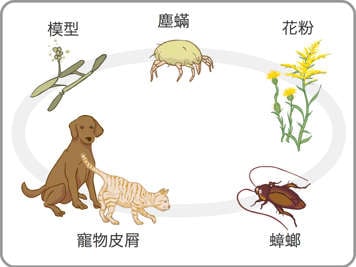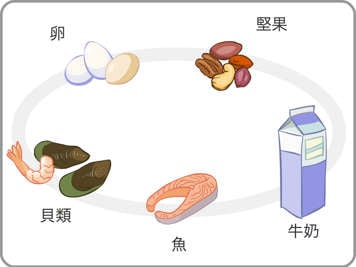什麼是過敏症?
人體免疫系統會攻擊病毒和細菌等有害物質,從而保護我們的健康。過敏是免疫系統對某些物質發生的反應,這些物質稱為過敏原。
過敏原對大多數人都不會造成傷害。然而,當孩子過敏時,免疫系統會將過敏原視為入侵物質,並發生過度反應,從而使過敏者出現程度各異的症狀。
過敏性疾病(包括食物過敏)是常見的兒童期病症。許多有過敏症的孩子也同時患有哮喘。
過敏原的種類
常見的空氣過敏原
塵蟎是一種常見的空氣過敏原。這些小蟲會在您家中溫暖、潮濕、灰塵較多的地方逗留,並通過食用死皮細胞而存活。它們的排泄物是引發過敏症和哮喘的主要原因之一。

其他常見的空氣過敏原包括:
- 來自花朵和其他植物的花粉
- 霉菌
- 寵物皮屑(寵物身上脫落的死皮細胞)
- 蟑螂
常見的食物過敏原

最常見的食物過敏原包括:
- 花生
- 木本堅果,例如榛子、胡桃、杏仁和腰果
- 蛋
- 牛奶
- 小麥
- 大豆
- 魚
- 貝類
對某些有過敏症的兒童來說,即使是少量的上述食物也會引發全身性過敏反應(anaphylaxis)。全身性過敏反應是最為嚴重的一種過敏反應,需要緊急醫療救助。孩子可能會出現皮疹(例如蕁麻疹)、呼吸困難、胃部不適(例如嘔吐)和低血壓(例如休克)等症狀。全身性過敏反應屬於緊急病症,患者需要立即就醫。應給過敏者施打腎上腺素(如有),並呼叫救護車。
常見的派對菜餚/食物(例如餅乾、蛋糕、糖果或其他食物)中也可能隱藏著食物過敏原。請務必詢問廚師或主人,確認菜餚/食物中是否含有會使您孩子過敏的成分。
比起食物過敏,更多人會對某些食物不耐受。與食物過敏不同,食物不耐受並不涉及人體的免疫反應,而是食物消化的過程使人體感覺不適。不耐受症狀會在吞咽或吸入食物後的數小時內慢慢顯現,不會立即發作。
其他常見的過敏原
- 昆蟲叮咬
- 藥物
過敏症的徵兆和症狀
過敏反應會因孩子的個體差異和接觸到的過敏原種類而異。您居住地區的地理位置也會影響過敏的類型和嚴重程度。
由空氣過敏原引發的過敏症狀
由空氣過敏原引發的常見過敏症狀包括:
- 打噴嚏
- 鼻子或喉嚨發癢
- 鼻塞或流鼻涕
- 雙眼發紅、發癢和/或多淚
- 咳嗽
- 呼吸時發出喘鳴聲或氣短
- 頭痛或耳堵
由食物過敏原或昆蟲叮咬引發的過敏症狀
孩子對食物過敏或昆蟲叮咬出現何種反應,取決於他們對食物或昆蟲的敏感程度。過敏症狀包括:
過敏症的病因
過敏原可與皮膚發生接觸,或通過呼吸、飲食或注射等渠道進入人體。
人體一旦探測到過敏原,免疫系統便會產生一種名為免疫球蛋白E(IgE)的抗體。這些抗體會使體內某些細胞釋放一種稱為組織胺的化學物質。組織胺能夠穿過血流,抵抗入侵物質或過敏原。
孩子的過敏症狀取決於其接觸過敏原的身體部位。絕大多數情況下,過敏反應會影響孩子的眼、鼻、喉、肺部或皮膚。
醫生如何幫助過敏症患兒
如果您懷疑孩子患有過敏症,請諮詢過敏專科醫生,他們是專門診斷和治療過敏症的醫生。
為確定孩子的過敏症,過敏專科醫生通常會:
- 為孩子檢查身體
- 詢問孩子的過敏史
- 詢問孩子的過敏症狀
隨後,您的孩子可能會接受皮試、抽血檢查、胸部X光檢查、肺功能測試或運動耐力測試。醫生會向您解釋這些檢查/測試的內容。
檢查/測試完成後,過敏專科醫生將根據結果進行診斷,並將安排後續約診,與您和孩子討論診斷結果。
如何為過敏測試做準備
在接受過敏測試前,您的孩子可能需要停用某些藥物一段時間,其中可能包括抗組胺藥。務必詢問醫生,確認孩子在就診前是否應停藥。
如何預防過敏反應
空氣過敏原
- 家中不要養寵物,如果已有飼養,則不要讓寵物進入孩子的房間,且應定期為寵物洗澡。
- 拆除或取走家中的地毯,尤其要確保孩子房中沒有地毯。硬質地面上粘的灰塵,比地毯要少得多。如果家中已鋪設固定地毯,每週至少應吸塵一次。
- 降低家中的相對濕度。
- 用熱水清洗床品,這有助於減少塵蟎。
- 在植物盛放季節,應關閉窗戶,減少孩子與室外花粉的接觸。使用帶有細微顆粒過濾器的空調系統。
- 清理掉家中會積聚灰塵的物品,包括厚重的窗簾,或久未清潔的陳舊傢具。
- 家中要經常打掃衛生,並按廠商建議定期更換家用暖爐的濾網。
- 如果孩子對塵蟎過敏,枕套和床墊罩要分別縫合。
- 浴室和其他易發霉的區域,應保持清潔乾燥。
食物過敏原
孩子必須避免食用所有會引發過敏的食物。隨著年齡增長,部分孩子可能不再對某種食物過敏,但其他孩子或需終身避免食用某些食物。
避免攝入食物過敏原並不容易,許多孩子都是誤食,導致出現過敏反應。
如果您的孩子有食物過敏,應教會他們需要避免哪些食物,以及這些食物的所有其他名稱。您和孩子應學習閱讀食物包裝上的產品標籤,並在外出就餐時詢問菜餚中的成分。您也應讓孩子瞭解,為什麼一定要確認食物配料中是否存在過敏原。
對於所有看護孩子的人士,您都應告知孩子的過敏症,並讓他們瞭解孩子必須避免的食物和飲品。
在家中照顧過敏症患兒
如果孩子患有嚴重過敏症,醫生可能會給您開具腎上腺素自動注射器(EpiPen)。醫生會告訴您自動注射器的使用方法和使用場合/時間。您或孩子可能需要隨身攜帶一支自動注射器。
盡可能減少孩子與過敏原接觸,以防止發生過敏反應。您採取的具體步驟取決於導致孩子過敏的物質。請與孩子的醫生探討這一問題。
出現過敏反應時,何時需尋求醫療救助?
如果孩子出現全身性過敏反應,請帶其就近前往醫院急診部或撥打911。全身性過敏反應的徵兆和症狀包括:
- 蕁麻疹,皮膚發紅、瘙癢
- 雙眼、嘴唇、舌頭或面部腫脹
- 呼吸困難、喉嚨發緊或吞咽困難
- 腹痛、惡心、 嘔吐或突然腹瀉
- 咳嗽
- 鼻塞和/或流涕、多淚、打噴嚏
- 昏厥、意識混亂、頭昏或暈眩
- 心跳過快或心律不齊
- 皮膚冰涼、濕冷或多汗
- 聲音發生變化
即使在施打腎上腺素(EpiPen)後,也應帶孩子就近前往急診部,因為過敏症狀可能會在給藥後數小時再次發作。
